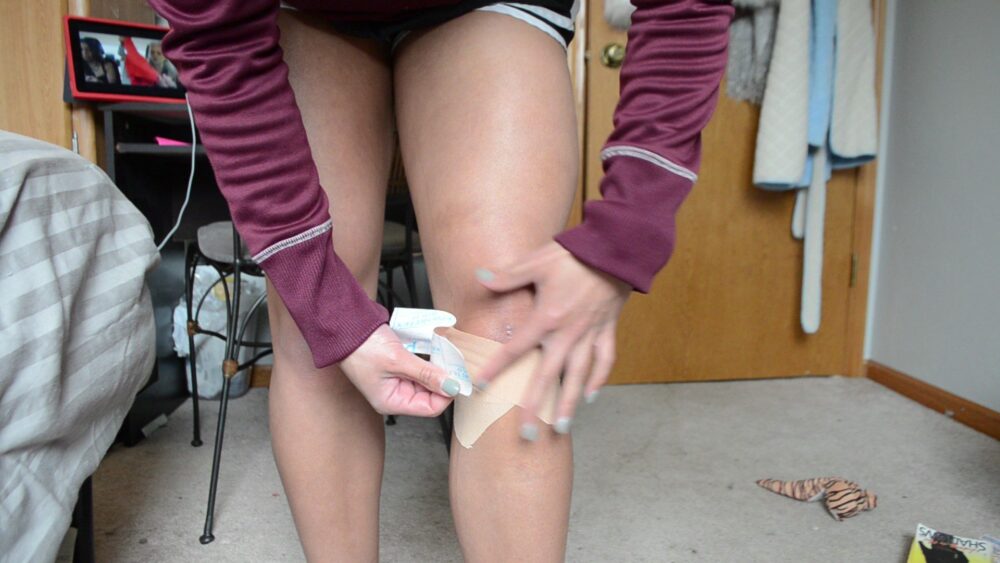After experiencing a total of 4 meniscus tears (two with an ACL tear and two on their own), I’ve come to know what a meniscus tear feels like.
With my ACL surgery, I had two meniscus repairs (medial and lateral). One failed a year later, leading me to a partial meniscectomy. Three years later, that same meniscus tore again and required another trim. I often speak with people who are concerned about a meniscus repair failing, or just a meniscus tear in general, so I wanted to share a bit more about how I knew it was torn.
I’m NOT a doctor or medical health professional of any kind. But, I want to share the symptoms I personally experienced when dealing with meniscus tears.
Keep reading for more information on the signs of a meniscus tear to watch for:
Localized Pain
My meniscus pain was in a very clear and specific area. It was not general knee pain or even general medial knee pain. Instead, I could point to exactly where the pain was. It was a fairly small and specific area. To me, this is one of the biggest markers of a meniscus issue vs an MCL or ligament problem.
Worsening Pain
Another aspect of the pain I noticed was how it progressed. For my second meniscectomy, I don’t even know when the tear began. As I talk about in my pre-surgery post, I just started to experience pain in the area. At first, the pain was only after workouts. Then it was during and after. Slowly, it became ALL of the time, including when I was trying to sleep!
Pain to the Touch
Most injuries hurt when you touch them. My meniscus tears were no different. When pressing on the joint line, I felt pain. They were painful to the touch. Just applying pressure would irritate my knee and cause pain.
Inconsistent Pain
One thing I want to make clear about the pain I dealt with for meniscus tears was that the pain was NOT consistent. After the first incident or concern, the pain was not always there or linearly progressive. Sometimes, it decreased or even went away for a couple of days.
This is not as much the case for my most recent tear, but definitely was when my meniscus repair failed. The moment (that I now know) it failed, it hurt. The pain worsened that day and was bad for a couple of days. But then it went down. It felt better. I was not in constant pain, even when training. It would hurt sometimes, for a day or so.
Basically, just because the pain seems to go away or is not always there, that does not mean your meniscus is fine.
Catching or Slipping Knee
All three times, abnormal knee function/ movement was a key marker. When I tore my ACL, my lateral meniscus was displaced (pushed into my knee). This locked my knee severely. I could not straighten it, it was stuck bent.
The second time, when my meniscus repair failed, catching and slipping was the first symptom. I detail the experience in this blog about my failed meniscus repair, but when I performed a cut while defending I felt my knee slip/catch. That was accompanied by pain. For months after, it would occasionally do this when I performed a fast-paced cutting movement during soccer.
I brought up this concern, but it was not taken seriously until the “final” incident. Again, I performed a reactive cut in a soccer game and felt the sliding feeling. The pain was immense at that time, and my knee instantly locked. It could not straighten all of the way once again.
The most recent time I tore my meniscus, I was not experiencing any catching or sliding until the “last incident.” Primarily, I dealt with growing and unbearable pain. But, during a friendly game, I made a reactive cut and felt a similar catching/ sliding feeling. The pain moved locations in my knee. While I could continue playing after the game the pain worsened and my mobility decreased.
My knee would feel “stuck” after being bent for a bit and I would not be able to straighten it. Then eventually it would crack loudly and could straighten. It was not moving fluidly and that led me to go to the doctor the next day.
How Do I Know if I Tore My Meniscus?
One of the most frustrating things about tearing your meniscus is that it’s hard to get a diagnosis. Even while still working with a PT during ACL return to sport, medical professionals overlooked my torn meniscus. I was questioning if the repair failed and was told that was unlikely. So I didn’t press to get an MRI or re-visit my surgeon…
All of that to say, the signs of a meniscus tear to watch for can help, but the best way to know if you tore your meniscus is to see a doctor. Even with that, they may not recommend scans if your pain seemed to get better. Depending on your lifestyle, it may be fine to wait and see, or to try PT and see if that helps enough. But if you’re a high-level athlete or in a labor-intensive job, then I recommend you push to get a full assessment and MRI.
